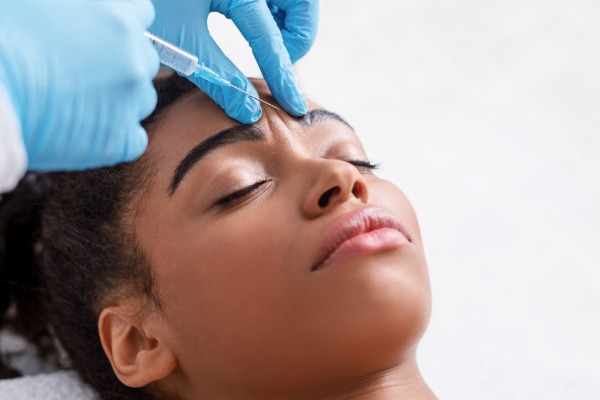
Procedure Time: 10-15 minutes
Recovery Time: No downtime
Results Duration: 3-6 months
Cost: Approx. £175 - £300 per treatment area
Anaesthesia: None
For a full list of FAQs please Click Here.
Botulinum toxin is a naturally occurring protein produced by the bacterium Clostridium botulinum. There are currently two different types of botulinum toxin commercially available in the United Kingdom: Type A toxin: Botox (Vistabel), Dysport (Azzalure) and Xeomin (Bocouture) and Type B toxin: Neurobloc.
Botulinum toxin can be used to treat all wrinkles which are the result of normal facial movement. When it is injected into a specific muscle in the face it blocks the signal from the nerve to the muscle. This means that the nerve ending cannot tell the muscle to move, hence there will be less wrinkling of the skin in the areas treated. The upper third of the face is where the best treatment results are obtained, commonly for the reduction in crow's feet around the eyes and wrinkles on the forehead and between the eyebrows. Depending on the area treated, dose used, and how you respond, repeat treatments will be required around every 3 - 6 months. Most clinics charge by area of the face treated: crow's feet, forehead lines, and glabellar lines, and may charge from £175 - £300 per treatment area. A discounted rate is often available for more than one area treated at the same time.
Do you have a question? Ask one of our experts NOWIt may surprise you to know that botulinum toxin, or Botox® as we commonly now call it, has a history stretching back almost two hundred years. In 1822, a German doctor named Justinius Kerner, suggested that botulinum toxin injections might be used in the treatment of excessive sweating or hyperhidrosis. Botox® is now regularly used for this condition.
By the late 1960s, Botox® had begun to be used in American clinics for the treatment of squints (strabismus).
Its use in treatment of the eyes was pioneered by an American called Alan Scott. Twenty years later, the real breakthrough came in the wider application of Botox® when Allergan, the American manufacturer of Botox®, was granted approval to market the drug by the Federal Drugs Agency. This gave Allergan the license to sell its new product throughout the U.S. Since then, Botox® has been registered and used in over 90 countries around the world, and other versions of botulinum toxin are also available in the UK, namely type A variants Azzalure®, Bocouture®, Dysport®, Vistabel® and Xeomin® plus type B variant Neurobloc®.
The next significant development in knowledge about botulinum toxin came in 1987 via a Canadian Ophthalmologist, Dr. Jean Carruthers. She had been treating her patients who suffered from blepharospasm with Botox®. Dr. Carruthers observed that a "side-effect" of this treatment was the reduction of crow's feet and wrinkles around the eyes. She then decided to test these findings scientifically, and she and her husband, a Consultant Dermatologist, (skin specialist) devised clinical trials to monitor the effectiveness of this treatment.
Since then, an enormous amount of clinical trial work and patient experience has been established using Botox® for the treatment of wrinkles, meaning that The American Society for Aesthetic Plastic Surgery (ASAPS) has consistently rated treatment with botulinum toxin as the most popular aesthetic procedure in the U.S.A. for many years.
Nearly a staggering 1,712,994 Americans had a Botulinum Toxin (Botox®, Dysport® or Xeomin®) treatment in 2019, a decrease of 4.9% on 2018 figures, but an increase of 17.8% when compared to 2015. This represents 55% of all non-surgical cosmetic treatments in the U.S.A. in that year.
Although there are as yet no similar detailed statistics available for the United Kingdom, it is likely that Botox® is also the number one procedure here.
Botox® is now licensed by the regulatory authorities in the U.S., as well as more than a dozen other countries around the world, for the treatment of glabellar lines and wrinkles.
In March 2006, Vistabel®, the brand name used for Botox® with a dosing specific to treat glabellar lines was granted a licence in the UK from the Medicines and Healthcare products Regulatory Agency (MHRA) for the "temporary improvement in the appearance of moderate to severe glabellar lines (vertical 'frown' lines between the eyebrows) in adult women and men aged 65 and younger, when the severity of these lines has a psychological impact for the patient".
The same licence was granted to Dysport®, under the brand name Azzalure® in March 2009 and to Xeomin® under the brand name Bocouture® in July 2010.
However, if you are considering having a botulinum toxin treatment in this country, the above is nothing to be alarmed about. U.K. practitioners can use any of the brands available, however they should make you aware that they are using them outside of their current U.K. licensed indications if applicable.
Science has discovered many other clinical uses for botulinum toxin including spasticity in adults and children, back pain, tension headache, migraine, dystonia, (spasm of the limbs) and anal fissure (tearing in the skin of the anus) which have all been treated successfully with this important product.
If you are considering treatment with botulinum toxin, the following information will give you a basic understanding of the procedure. It can't answer all your questions, since a lot depends on the individual patient.
Please ask a practitioner about anything you don't understand.
Botulinum toxin is a naturally occurring protein produced by the bacterium Clostridium botulinum. This bacterium makes several different types of protein which are called type A to type F. These varying proteins cause muscles to relax at different levels.
There are currently two different types of botulinum toxin commercially available in the United Kingdom – type A toxin (including the brands Botox®, Vistabel®, Dysport® , Azzalure® and Xeomin® and Bocouture®) and type B toxin (Neurobloc®).
Our facial expressions change because the muscles in the face contract or relax. This is caused by the brain sending a signal via our nerve endings that we want to, for example, frown or laugh. When botulinum toxin is injected into a specific muscle it blocks the signal from the nerve to the muscles in the face. This means that the nerve ending cannot tell the muscle to move. This is not a permanent condition, however, but it will last for around 3 - 4 months.
After botulinum toxin injections, your skin around the area which has been treated will look smooth and less wrinkled; but do not worry, the rest of your face will not be affected. Botulinum toxin allows the untreated areas of your face to move as normal and you will still be able to laugh, smile and frown, but with less wrinkling of the skin in the areas treated.
After a while, most patients will notice that the lines and wrinkles around their treated areas will continue to become less deep and pronounced. This is a result of the botulinum toxin as the new skin has a chance to grow without being repeatedly creased. Hence, it appears to be smoother on the surface because it has not been creased by constant muscle activity.
Botulinum toxin can be used to treat all wrinkles which are the result of normal facial movement. It is not suitable for permanent wrinkles caused by excessive exposure to the sun.
Botulinum toxin does not remove wrinkles indefinitely; it is usually necessary to have a treatment every 3 - 4 months to maintain and improve upon the original results. It has been proven to be quite safe to have botulinum toxin injections at the above frequency over a period of years.
The upper third of the face is where the best treatment results are obtained, commonly for reduction in the appearance of crow's feet around the eyes, and frown lines and wrinkles on the forehead and between the eyebrows.
Experienced practitioners can use botulinum toxin to reduce the appearance of fine lines underneath the eyes as long as the skin is not too loose in this area before the treatment. This procedure often leaves the patient with a slightly wider open - eyed look.
Botulinum toxin can also be used to reposition or lift the eyebrows by a few millimetres. This is sometimes called a “chemical brow lift”. It can lessen so-called “bunny lines” (lines along the top of the nose caused when some people smile.) More seriously, it can help people who have suffered facial trauma or Bell's palsy. In these cases, the face can take on a “lop-sided” look, and botulinum toxin can help to correct this distressing condition.
Experienced injectors may also treat fine vertical lines in the lip area and around the corners of the mouth. Usually in these cases, an injection of botulinum toxin would be accompanied by a dermal filler. This literally fills up some of the deeper wrinkles like a cosmetic polyfilla!
A dimply chin caused by the underlying muscle that occurs in some people can also be softened as can “necklace lines” or horizontal lines around the neck.
“Platysmal bands” – bands of muscle that stand out from the neck and make the neck look stringy in appearance can also be softened with botulinum toxin.
Preparing for treatment
This treatment is simple, quick and safe. You can resume your normal activities immediately after the procedure. Many people have their treatments in their lunch-time, for example, and return to work straight afterwards.
The first time you visit a clinic, a detailed discussion with a practitioner should realistically and clearly highlight your expectations of the cosmetic effect from this treatment. The practitioner should then be able to tell you if this is how they see the treatment working for you. If your expectations and theirs do not match each other, do not proceed until you are entirely happy with what they are telling you.
The practitioner may then take a medical history to make sure that there are no reasons why you are not suited to be treated with botulinum toxin. Then you would normally be asked to sign a consent form indicating that you have understood what the treatment may do, the potential side effects and also that the drug is not currently licensed for this specific use in the U.K..
Photographs may also be taken by the practitioner with you smiling and frowning and with your face at rest. This will be used as “before and after” images to show you how successful your treatment has been.
All this may happen in your first visit. If you are happy to proceed further, the practitioner may also give you a first injection at this time. Equally, you may decide to keep your treatment separate from the consultation and consent process and not begin the procedure until your next consultation.
The injections
First, the area to be injected will be cleaned with an antiseptic wipe. You do not require any anaesthetic or sedation. Then, using micro needles and disposable syringes, tiny amounts of botulinum toxin, will be injected into several points in the agreed area.
For your first treatment, we recommend that it might be wise to have just one area treated (i.e. your frown lines, for example) so that you can become comfortable with the process and the practitioner can see how you respond to your first injections.
Repeat procedures
Depending on the area treated, dose used, and how you respond to botulinum toxin, repeat treatments will be required around every 3 - 6 months. These will maintain and potentially improve upon the initial effect observed.
The whole treatment should usually take no longer than 10 – 15 minutes and you can normally drive immediately afterwards and go about your usual activities.
Most patients find that Botox® injections cause little discomfort. Many compare the feeling to a little insect bite! As the treatment is very quick, the needles used are tiny and only minute amounts of liquid are being injected into the skin; few patients experience any significant pain.
A few patients do, however, prefer to have an aesthetic cream applied half an hour or so prior to treatment to help numb the skin.
Other risks or side effects include a small amount of temporary bleeding or mild swelling which may occur at the injection site. In some cases more extensive bruising may occur, especially around the eyes, but this can usually be covered up with make-up, and is only temporary.
Occasionally, patients experience a headache after treatment, and, very rarely, double vision.
When botulinum toxin is injected into the forehead area, there is a very slight possibility that it may cause weakness of the muscle holding up the eyelid causing a “partial ptosis” or drooping of the upper eyelid.
In experienced hands this tends to happen in less than 1% of patients and will disappear over a period of 2 - 10 weeks. Some doctors also use an eye drop called apraclonidine to help to speed up the recovery if this effect occurs.
If the forehead muscles are relaxed too much, especially in patients with looser skin, the treatment may cause the eyebrows to drop slightly. Again, this is only a temporary condition and will vanish usually within 10 weeks.
Sometimes, the eyebrow position may alter so that the edges of the eyebrows become elevated. Some women like this effect, but it is generally unwanted in men. It is easily corrected with a small amount of botulinum toxin injected above the raised area of the eyebrow to help change its position.
All patients should remember that because the results of botulinum toxin are not permanent, any unwanted effects will disappear usually within a 3 month period.
During 2003 there were some press reports claiming that Botox® may cause more wrinkles to appear. We have looked at these claims and can find no evidence in the scientific literature, at this point, to support these reports.
As we have said, your life can proceed as normal following an injection of botulinum toxin, but as with all medical procedures, it is wise to observe the advice of your practitioner as closely as possible to ensure that you get the full benefit of the treatment, free from complications.
Post-treatment advice may include:
Botulinum toxin should not be used in women who are pregnant or breastfeeding. The manufacturers have not performed clinical studies in this group, for obvious reasons, although it is not thought to be dangerous to developing babies.
If you are currently trying for a baby, it might be wise to delay any cosmetic treatment.
Patients who have any diseases that affect muscle activity, may not be suitable for botulinum toxin injections. You must discuss this with your practitioner. Your practitioner may also ask you if you have a history of Bell's palsy as this may affect the dosage that they use.
If you have any bleeding disorders or are taking drugs that affect bleeding time, or certain aminoglycoside antibiotics, your practitioner may advise against treatment.
You should be prepared to tell your practitioner about any medication which you are taking and any allergies you have.
Owing to the popularity of botulinum toxin, you can find this treatment available in a wide variety of settings and being offered by practitioners as varied as dentists, plastic surgeons, general surgeons, dermatologists, (skin specialists) general practitioners, gynaecologists, ophthalmologists (eye specialists), cosmetic doctors and nurses.
Beauticians, beauty therapists and other non-medics are not allowed to inject botulinum toxin as it is a Prescription Only Medicine (POM).
Nurses are allowed to inject botulinum toxin (acting under a prescriber's instruction), but you should have seen a doctor, dentist or independent nurse prescriber first to ensure your suitability for treatment.
Please ensure that you remember to ask about a practitioners training and experience - especially if you want this treatment in the lower part of your face or neck.
For more information about practitioner training, qualifications and relevant medical organisations please view the information contained within the Legislation section of the Consulting Room™.
Please also note:
Under the Medicines (Advertising) Regulations 1994 [SI 1994/1932, as amended] and the Committee of Advertising Practice (CAP) code, botulinum toxin brands which are Prescription Only Medicines (POMs) should not be advertised or promoted to the public. Advertising for cosmetic clinics and services may promote the service provided, e.g. "treatment for lines and wrinkles" or "wrinkle relaxing treatment", as this is non-specific and may include various procedures. However, advertising must not mention "Botox®", "Vistabel®" "Dysport®", "Azzalure®", "Xeomin®", "Bocouture®" and "Neurobloc®", or "botulinum toxin", "BTX-A" etc. as this is prohibited by the regulations.
Therefore, in compliance with the legislation, when you search for a practitioner or view a clinic profile within the Consulting Room™ website you will not find these products or services directly promoted or advertised.
Most clinics and practitioners charge by area of the face treated for this cosmetic procedure.
These areas are usually defined as crow’s feet, forehead lines, and glabellar lines (frown lines between the eyes).
Practitioners may charge from around £175 - £300 per treatment area.
A discounted rate is usually employed if more than one treatment is required, so that crow’s feet, forehead lines, and glabellar lines prices may be £500 or less for the complete package.
Beware of very low quoted prices as some practitioners use doses of botulinum toxin or Botox® / Vistabel® which are lower than those recommended. In such cases, the initial effect may be good, but the treatment will not last as long. Hence, you may require more injections than are the suggested norm during the year. You may save money initially on a cheaper treatment, but if you need more visits to your practitioner during the year, it could cost you more overall.
Although you might have read words such as "poison" or "toxic substance" to describe the effects of botulinum toxin, this is usually just the work of sensationalist journalists who are not very well informed. There is now a huge amount of clinical and practical evidence that has been generated over the last 15 years in support of the effectiveness and safety of botulinum toxin in all its uses.
On the basis of clinical evidence, most practitioners would now recommend an initial course of treatment every 3 or 4 months for the first year for the cosmetic treatment of lines and wrinkles. It now appears that after this, the time between future injections may lengthen, with practitioners reporting that some patients may only need to return twice a year to maintain results.
Remember that the main use of botulinum toxin is to treat lines and wrinkles associated with underlying muscle movement in the upper part of the face (and some areas around the lips, chin and neck). It is not a suitable treatment for criss crossed or static lines in areas such as the cheek.
The overall effect of botulinum toxin or Botox® injections in reducing the appearance of wrinkles over a period of time will depend upon the depth and extent of wrinkles before treatment. If lines are already deep and engrained, you may find that a combination of other procedures are recommended instead of, or in conjunction with this treatment.
Before and after photographs are real patients, your results may differ.
Photographs below courtesy of Dr David Eccleston at Medizen.
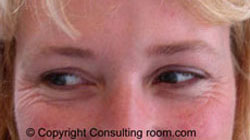
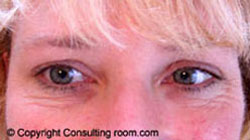
37 year old patient smiling before Botox® injections and smiling 7 days following Botox® injections to her right eye only to demonstrate the effect on reducing the appearance of crow's feet.
Note: Botox® was injected into the crow's feet area and does not improve the appearance of loose skin beneath the eye.
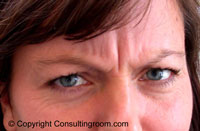
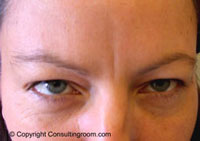
40 year old patient frowning before first Botox treatment and trying to frown 7 days after treatment
Photographs below provided courtesy of Lasercare Clinics (now Sk:n Clinics).
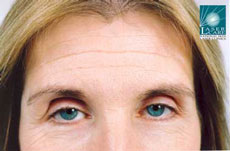
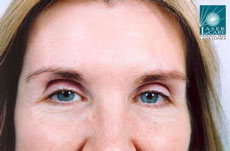
46 year old female with forehead lines before treatment with Botox® injections and showing a significant improvement 10 days after treatment..
Photographs below provided courtesy of BotoMedics Ltd.
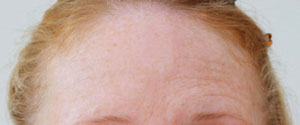
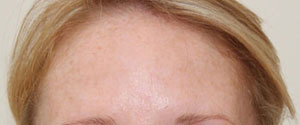
Female forehead before treatment and 14 days post treatment with Botox®.
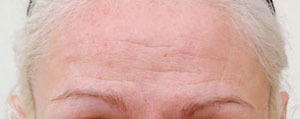
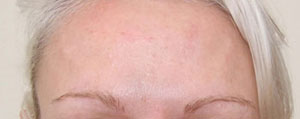
Female forehead before treatment and 14 days post treatment with Botox®.
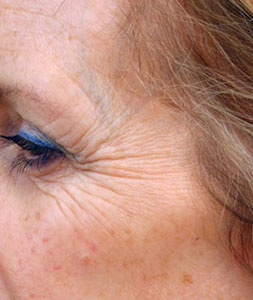
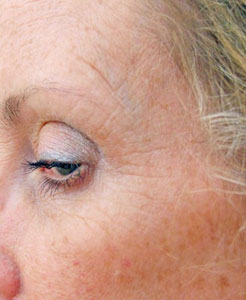
Female crow's feet before treatment and 14 days post treatment with Botox®.
Photographs below courtesy of Dr David Eccleston at Medizen.
The two before photographs (below on the left) show a lady with prominent jaw muscles that make her face look squarer and less feminine. Two months after skillful injection of Botox® into the jaw muscles there was considerable reduction in muscle mass, producing a more feminine, oval shape to her face, (see after photographs below on the right). To see more before and after images of Botulinum toxin visit MediZen.
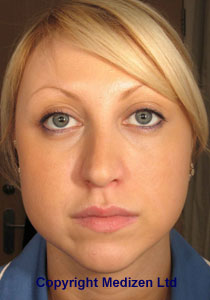
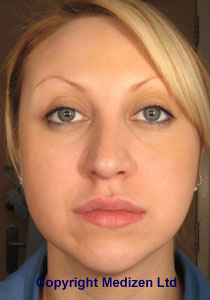
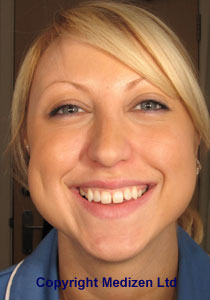
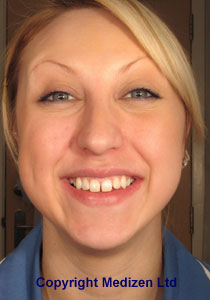
Photographs below courtesy of Dr. Marc Armangue at Medical Aesthetics Ltd.
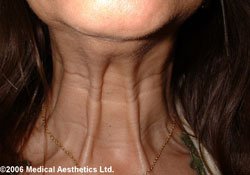
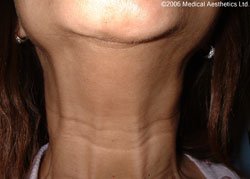
49 year old female patient had botulinum toxin injections to reduce and prevent the appearance of “turkey neck” (platysmal bands). Reduction in the platysmal bands in the neck after treatment.
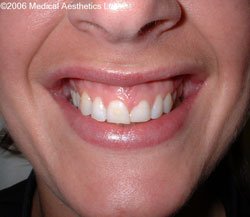
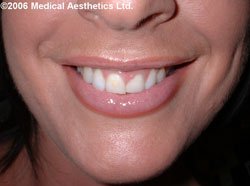
30 year old female patient had botulinum toxin injections to correct the "gummy smile" appearance. Significant reduction in the appearance of a "gummy smile" after treatment.
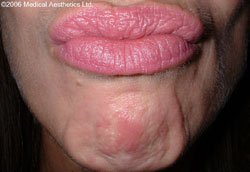
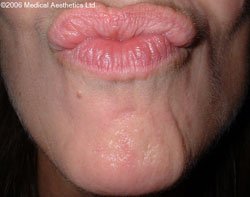
41 year old female patient had botulinum toxin injections to reduce and prevent the appearance of popply chin (by contraction of the mentalis muscle). Significant reduction in the appearance of a "popply chin" after treatment.
Before and after photographs are real patients, your results may differ.